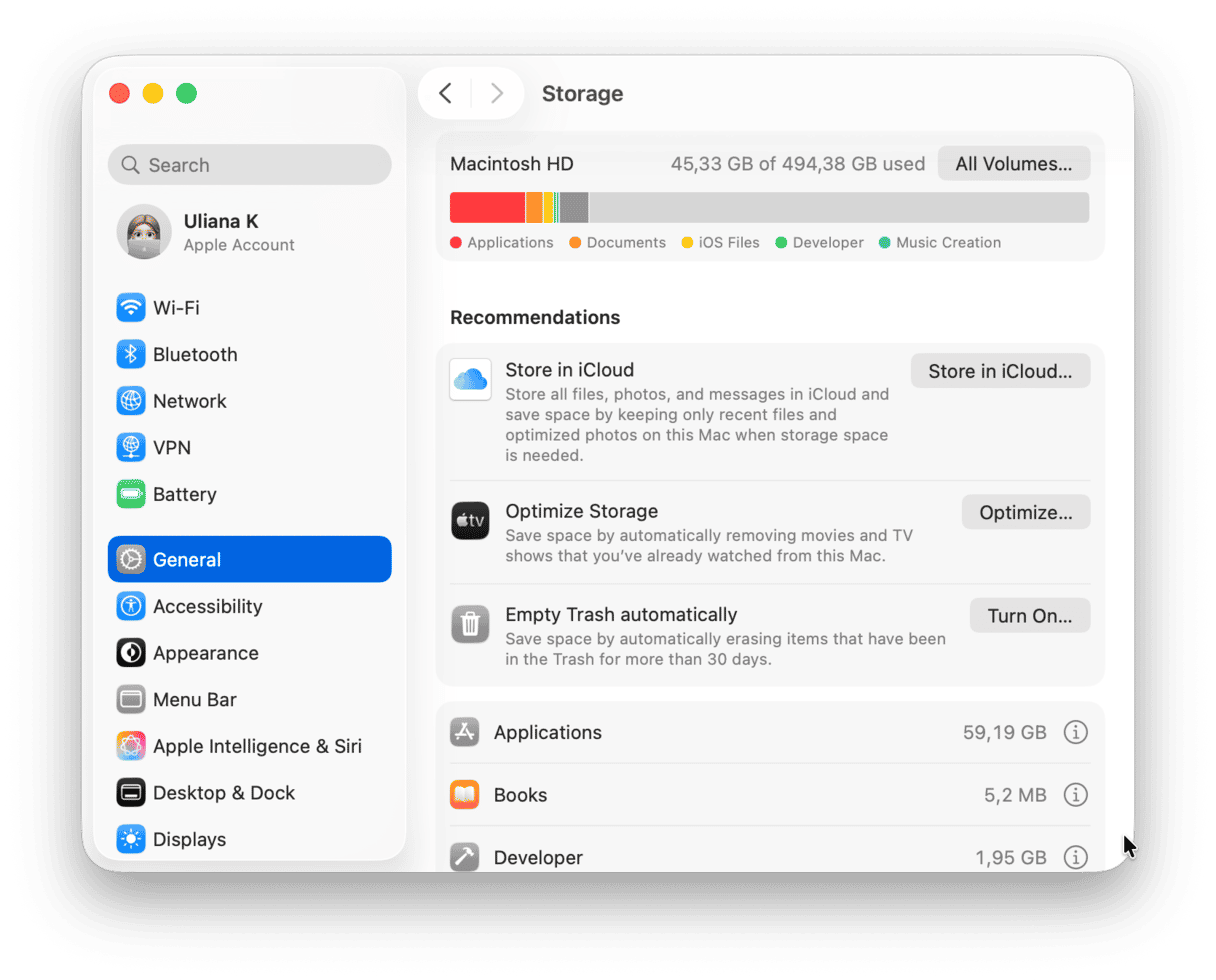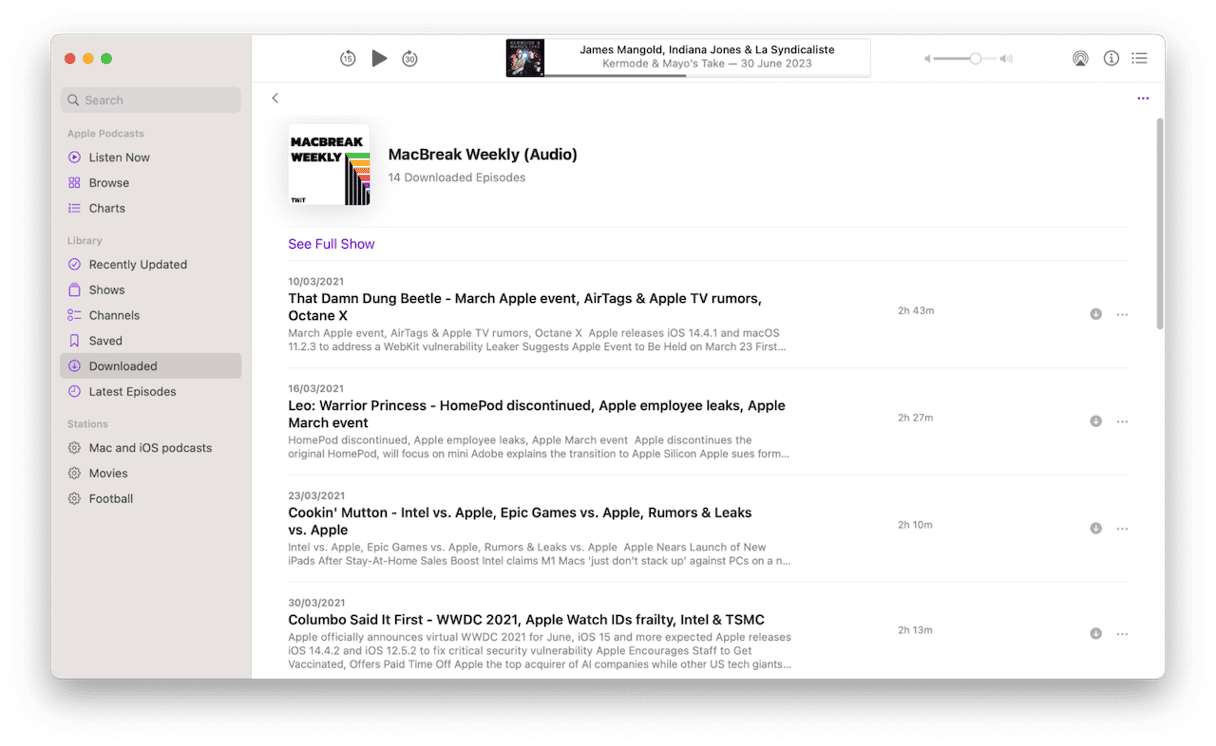If you’re excited to install macOS Sonoma on your Mac, you should make sure you prepare for it before you try installing it. The most important part of that is to back up your Mac. Don’t even think about updating to macOS Sonoma until you’ve backed up. Using Time Machine is perfect because you can easily restore your Mac from it. Even if you prepare carefully, though, you may still find that there is not enough space to install Sonoma. In this article, we’ll show you what to do if that happens. As a bonus, you will learn how to free up space on Mac for Sonoma.
How much space does macOS Sonoma take?
The installer for macOS Sonoma is only around 12GB in size. However, you’ll need much more space than that to install Sonoma on top of the existing version of macOS on your Mac. You should make sure you have at least 25GB of free space on your Mac before you start.
How to check free storage space on your Mac
- Click on the Apple menu and select System Settings, then General.
- Select Storage, and you will see how much free storage you have on your Mac.
- While you’re there, you can also follow the Recommendations to free up storage.

How to free up more storage space on your Mac
There are lots of things you can do to free up space on your Mac, and it’s usually much easier than you think. Here are a few things you should try.
1. Empty your Downloads folder
This is a really easy one. Your Downloads folder is not intended to be a permanent home for files. If you have a look inside it, it’s probably full of disk images and installers and old PDFs. Archive the files you want to keep elsewhere and then drag the rest to the Trash and empty it.
2. Remove system junk
Your Mac accumulates lots of junk files as you use it. These include cache files, temporary files that were supposed to have been deleted but weren’t, and language files for languages you don’t use. Over time, these files can take up several gigabytes of space on your Mac. And they can slow it down or cause it to be unstable.
Fortunately, the Cleanup feature in CleanMyMac lets you eliminate all the unneeded junk files with a few clicks. It’s very easy to use, and you can free up several gigabytes of space very quickly. Start your free CleanMyMac trial.

3. Delete iPhone and iPad backups
If you back up your iPhone or iPad to your Mac, old backups can take up quite a bit of space on your Mac. Even if you’ve only backed up an iPhone or iPad once to your Mac — say, before updating it to a new version of the OS — that can take up several gigabytes of space.
If there’s not enough space to update Mac, you can remove the backups from your Mac and free up the space it takes by doing the following:
- Plug your iPhone or iPad into your Mac.
- Open a new Finder window.
- Select the iPhone or iPad in the Finder sidebar under Locations.
- In the main window, select Manage Backups.
- Select the backup you want to remove and then click Delete.
4. Get rid of old podcasts
If you listen to podcasts on your Mac and download them in the Podcasts app, you may have a few gigabytes’ worth on your startup disk. There’s an easy way to check and delete them.
- Go to System Settings > General and select Storage.
- Look for Podcasts. Next to it, you will see a figure for the amount of storage it’s using.
- To delete podcasts, click ‘i’ and select Open Podcasts.
- Select Downloaded in the sidebar.
- To delete podcasts, click on a show in the main window.
- Click on the three dots at the top right corner of the window and select Remove. Confirm deletion.

5. Move large and old files to another disk
The two most effective and easiest groups of files to move to an external disk are those that take up the most space and those that you haven’t opened in a long time. In other words, large and old files. Moving or deleting these will free up much space and cause minimal disruption.
Identifying these files on your own is time-consuming. However, CleanMyMac can help. Its My Clutter feature scans your Mac, helping you identify large files that haven’t been opened for a while, duplicates, similar images, and unneeded downloads. You can then choose which ones to move or delete to free up space.

6. Get rid of old disk images
We all do it. We download a new app, install it and then forget about the disk image. And before we know it, we have lots of old disk images taking up space on our Mac. They will almost certainly never be used again because even if you uninstall the app and need to reinstall it, you should redownload a new up-to-date disk image rather than use an old one. So, get into the habit of dragging disk images to the Trash as soon as you’re finished with them. For now, open a Finder window and search for ‘.dmg’ files. Then drag the disk images it finds to the Trash.
7. Uninstall apps you don’t use
Another thing many of us do is install applications, try them out, and then never use them again. These, too, take up space. You can uninstall App Store apps from Launchpad by holding down the Option key and clicking ‘x’ or using the developer’s own uninstaller if there is one. You can also use the Applications feature in CleanMyMac, which removes any application and all of its associated files.

Frequently asked questions
How much space does macOS Sonoma need?
At the time of writing, Apple hasn’t said how much free space your Mac should have available. However, working from previous versions, it would be sensible to make sure you have at least 25GB of free space.
What’s the quickest way to free up space?
Identifying and removing the largest files on your Mac and those you haven’t opened in a long time will free up lots of space and cause very little disruption. Focusing on the largest files means you have to remove fewer to free up a significant amount of space, and getting rid of those you haven’t opened in a while means you are less likely to notice they are not there.
Is it safe to get rid of iPhone and iPad backups?
Yes, as long as you have a recent backup somewhere else, like iCloud. If you set your iPhone or iPad to back up to iCloud, then you won’t need the backups on your Mac to restore your device.






